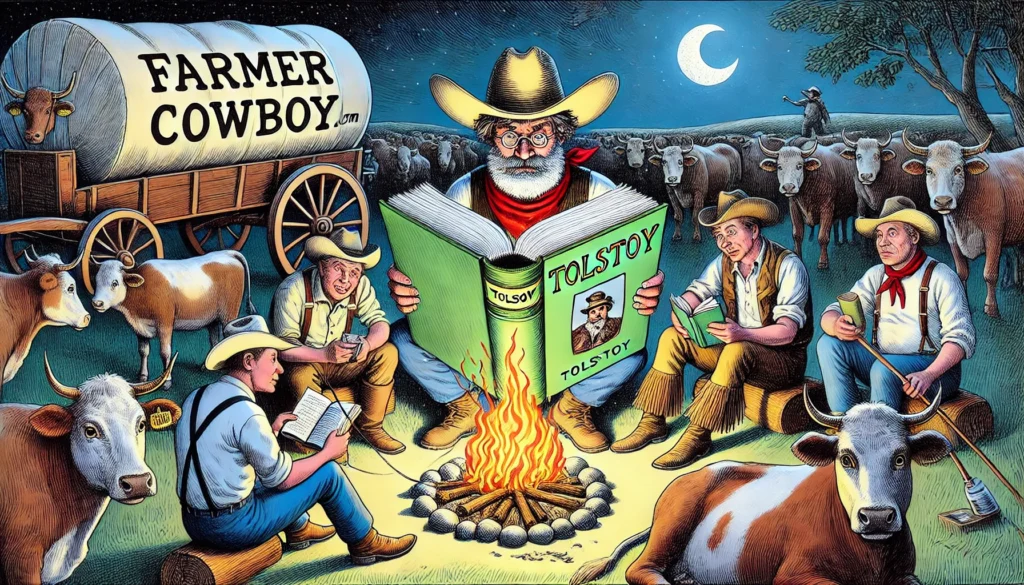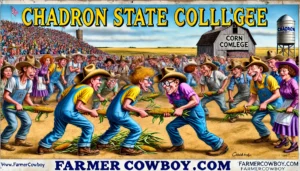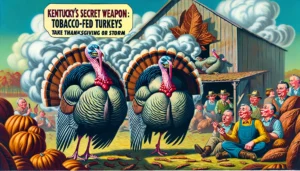
Cowboys who READ A vivid and detailed satirical image in the style of Mad Magazine showing a cowboy sitting by a campfire at night deeply engrossed in reading a gian.webp.webp
Cowboys Who Read: How Tolstoy Turned Rodeo Nights into Russian Epics
From Lassoing Calves to Lassoing Words: The Surprising Literary Life of the Modern Cowboy
El Paso, TX—In a dusty corner of Texas, where the sun-baked plains stretch for miles and the scent of leather and hay permeates the air, a peculiar trend has emerged among cowboys. It seems that between wrangling cattle and taming wild horses, these rough-and-tumble riders have found solace in the literary works of none other than Leo Tolstoy. Yes, you read that right—Tolstoy.
As one might imagine, the juxtaposition of cowboy culture and Russian literature has produced some eyebrow-raising moments. “At first, I thought War and Peace was some kinda instruction manual for ranch wars,” said Buck “Spurs” Thompson, a local cowboy whose reading habits now include more Russian epics than rodeo magazines. “Turns out, it’s a whole lotta talkin’ about life and stuff. Kinda like the ranch after a long day, minus the dust and whiskey.”
A Growing Trend
This unexpected literary renaissance began when a local bookstore mistakenly shipped several copies of War and Peace to the town’s only feed store. “We were supposed to get feed catalogs,” said the store owner, Hank “Grizzly” Jones. “But instead, we got these thick Russian books. We didn’t know what to do with ’em, so we started giving ’em out with every bag of feed. Figured the boys might use ’em as paperweights or firewood.”
To everyone’s surprise, the cowboys didn’t just toss the books aside. Instead, they began reading them, often during downtime at the rodeo or while waiting for cattle to graze. “I’ll admit, it’s a bit strange seeing a cowboy with a six-shooter on one hip and Tolstoy on the other,” said Sheriff Rusty McGraw. “But hey, if it keeps ’em outta trouble, I’m all for it.”

A Shift in Cowboy Culture
The impact of Tolstoy on cowboy culture has been profound. Gone are the days when cowboys spent their evenings around the campfire, telling tall tales and swapping stories about the day’s events. Now, they debate the philosophical implications of Tolstoy’s characters, comparing Napoleon’s battles to their own struggles with unruly livestock.
“I used to think the biggest battle in life was stayin’ on a buckin’ bronco for eight seconds,” said Jake “Bronco” Miller. “But now, after readin’ War and Peace, I realize that life’s battles are more about inner turmoil and moral dilemmas. It’s deep, man.”
The literary discussions have even spilled over into the rodeo arena. “We had a whole debate the other day about whether Anna Karenina would’ve been better off if she’d just taken up bull ridin’ instead of romance,” said Tom “Twister” Johnson, a cowboy who now spends as much time reading as he does riding. “We figure she’d be tougher if she’d faced down a few bulls.”
Public Opinion: Divided
Not everyone is thrilled about the cowboys’ newfound love for Tolstoy. Some locals worry that the literary influence is softening the tough-as-nails image of the cowboy. “I don’t know what’s happenin’ to this town,” said Martha “Granny” Jenkins, who’s lived in El Paso her whole life. “First, they started drinkin’ fancy coffee, and now they’re readin’ Russian novels. Next thing you know, they’ll be doin’ yoga.”
Others, however, see it as a sign of growth. “I think it’s great,” said Linda “Bookworm” Sanders, a local librarian. “It just goes to show that you can’t judge a book by its cover—or a cowboy by his hat.”
Expert Insights
Literary experts have weighed in on this unlikely pairing, with some speculating that the cowboy’s love for Tolstoy may stem from the shared themes of struggle and perseverance. “Tolstoy’s works often deal with the harsh realities of life, much like the cowboy lifestyle,” said Dr. Edith Wharton, a professor of literature at the University of Texas. “It’s not surprising that they’d find a connection there.”
Dr. Wharton also noted that Tolstoy’s detailed descriptions of Russian landscapes may resonate with cowboys who spend their days in the vast, open spaces of the American West. “There’s a certain poetry in both,” she said. “Whether it’s the Russian steppes or the Texas plains, it’s about man’s relationship with the land.”
Anecdotal Evidence
For many cowboys, reading Tolstoy has become a way to unwind after a long day on the ranch. “I used to come home, crack open a beer, and watch TV,” said Billy “Bullseye” Parker. “Now, I sit on my porch with a glass of whiskey and dive into Tolstoy. It’s kinda like a mental rodeo—keeps my mind sharp.”
Billy isn’t alone. Many cowboys have reported that reading Tolstoy has given them a new perspective on life. “I used to think it was all about ridin’ and ropin’,” said Slim “Saddle” O’Reilly. “But now, I realize there’s more to life—like ponderin’ deep questions and stuff.”
Statistical Evidence
According to a recent survey conducted by the El Paso Public Library, 35% of local cowboys have read at least one work by Tolstoy in the past year. Of those, 82% reported that they found the experience “challenging but rewarding,” while 15% admitted they “mostly skimmed the long parts.” The remaining 3% confessed they “used it to prop up a wobbly table.”
Textual Evidence
Tolstoy himself once wrote, “The strongest of all warriors are these two—Time and Patience.” It seems that cowboys have taken this to heart, as they tackle Tolstoy’s lengthy novels with the same determination they bring to the rodeo. “It’s like breakin’ a wild horse,” said Dusty “Trailblazer” Jackson. “You gotta be patient, but once you get through it, there’s a sense of accomplishment.”
Analogical Evidence
The parallels between Tolstoy’s characters and cowboy life are hard to ignore. Just as Napoleon faced challenges on the battlefield, cowboys face their own battles in the rodeo arena. And just as Tolstoy’s characters grapple with moral dilemmas, cowboys must navigate the complexities of ranch life. “It’s all about survivin’ and adaptin’,” said Clint “Cowpoke” Harris. “Whether you’re fightin’ a bull or fightin’ your inner demons, it’s a battle either way.”
Hypothetical Evidence
Imagine a cowboy riding into town, dusty and tired from a long day on the range. Instead of heading to the saloon, he pulls out a copy of War and Peace and settles in for some serious reading. It may sound far-fetched, but in El Paso, it’s becoming the norm. “I never thought I’d see the day when cowboys would be more interested in Tolstoy than poker,” said saloon owner Jack “Whiskey” Wilson. “But here we are.”

“Who knew cowboys could wrangle War and Peace between rounds of calf-roping?”
The local rodeo has become a hub not just for feats of physical prowess but intellectual endurance. Cowboys can be seen sitting on the fence, book in one hand, lasso in the other, pondering the complexities of Tolstoy’s characters. “War and Peace ain’t so different from a rodeo,” said one cowboy. “You just gotta hold on tight and hope you don’t get bucked off by all them Russian names.”
“Turns out, Tolstoy was just as long-winded as a cowboy telling a story after five whiskeys.”
If there’s one thing cowboys appreciate, it’s a good story. But even the most seasoned storyteller in the saloon can’t compete with Tolstoy’s epic sagas. “I thought I was a talker,” said old Buck McGraw, “but this Tolstoy fella? He could stretch a yarn longer than a rattlesnake in the sun.”
“Is it a rodeo or Russian roulette when cowboys tackle Tolstoy? Either way, it’s a gamble.”
Taking on Tolstoy is no small feat, and the cowboys know it. Whether it’s the confusion of keeping track of 500 characters or trying to find meaning in 1,200 pages of philosophical musings, every cowboy knows he’s in for a wild ride. “I reckon it’s like ridin’ a bull named Existential Crisis,” said one cowboy with a knowing grin.
“From broncos to brooding Russians: Cowboys discover existential crises are just like rodeo clowns—inevitable.”
Who knew that Tolstoy and rodeo had so much in common? Just as every cowboy expects a rodeo clown to appear after a fall, they now anticipate an existential crisis after a few chapters of Tolstoy. “It sneaks up on you,” admitted Dusty, a local bronc buster. “One minute you’re readin’ about a ball, and the next, you’re questionin’ the meanin’ of life.”
“Cowboys reading Tolstoy: Proof that even the wildest buckaroo can appreciate a good plot twist.”
Nothing catches a cowboy off guard like a good plot twist, and Tolstoy delivers in spades. “It’s just like when you think you’ve got that bull under control, and then bam, you’re on the ground,” said Slim, a seasoned rider. “Tolstoy does that with words.”
“Tolstoy’s battles aren’t so different from rodeo showdowns—just swap the swords for spurs.”
The cowboys have found that the battles described in War and Peace aren’t so different from their own showdowns in the rodeo arena. “Napoleon had his Waterloo, and I had my showdown with Old Thunder,” mused one cowboy, drawing parallels between historical warfare and the rodeo ring.
“Rodeo meets Russian literature: Cowboys now debate who was tougher—Napoleon or the average bull.”
The debate rages on in the saloons of Texas: Who was tougher, Napoleon or the bulls of the rodeo? “Napoleon might’ve had his armies,” argued Jake, “but he never faced down a 2,000-pound bull with nothin’ but his wits and a pair of spurs.”
As the sun sets over the plains and the cowboys sit around the campfire, Tolstoy has found a new home in the hearts of America’s roughest riders. Whether they’re branding cattle or diving into Russian literature, one thing’s for sure: cowboys will always find a way to tackle life’s toughest challenges, even if those challenges come in the form of a 1,200-page novel.

Step-by-Step Guides, Pro Tips, and Insider Knowledge
For those cowboys looking to get started on their literary journey, here are some insider tips:
- Step 1: Start with the short stories. Tolstoy’s novels can be intimidating, so ease into it with something shorter, like The Death of Ivan Ilyich. It’s still heavy, but at least it won’t take a month to read.
- Pro Tip: Keep a flask of whiskey handy. You’ll need it for the dense philosophical parts.
- Insider Knowledge: Tolstoy loved nature, so try reading outdoors. It’ll make the descriptions of Russian landscapes feel more relatable.
- Best Practices: Don’t be afraid to skip the long, tedious sections. Tolstoy himself probably would’ve appreciated a good editor.
- How-to Tutorial: If you get stuck on a chapter, imagine the characters as cowboys. It won’t make the story any shorter, but it might make it more fun.
- Practical Advice: Join a book club. Discussing Tolstoy with fellow cowboys can make the experience more enjoyable—and you might pick up on things you missed.
Conclusion: A New Era of Cowboy Culture
As the sun sets over El Paso, one thing is clear: the cowboys of today are as tough and resilient as ever, but they’ve added a new skill to their repertoire—literary analysis. Who would’ve thought that Tolstoy, with his brooding Russians and endless philosophical debates, would find a home on the range? But in a world where anything is possible, it seems that even cowboys can appreciate the finer points of Russian literature. And who knows? Maybe one day, Tolstoy will be required reading at rodeo school.
Disclaimer
This story was written in collaboration between a cowboy and a farmer, with no involvement from AI. Any resemblance to real-life cowboys reading Tolstoy is purely coincidental, but if you happen to see it, we take full credit. Remember, not all cowboys are intellectuals—some just look the part.
15 Humorous Observations with Wordplay and Witty Puns
- Who knew cowboys could wrangle War and Peace between rounds of calf-roping?
- Turns out, Tolstoy was just as long-winded as a cowboy telling a story after five whiskeys.
- Is it a rodeo or Russian roulette when cowboys tackle Tolstoy? Either way, it’s a gamble.
- From broncos to brooding Russians: Cowboys discover existential crises are just like rodeo clowns—inevitable.
- Cowboys reading Tolstoy: Proof that even the wildest buckaroo can appreciate a good plot twist.
- Tolstoy’s battles aren’t so different from rodeo showdowns—just swap the swords for spurs.
- Rodeo meets Russian literature: Cowboys now debate who was tougher—Napoleon or the average bull.
- War and Peace may be long, but so is a cowboy’s patience after wrangling cattle all day.
- Cowboys finally find something harder to understand than a horse’s mood—Tolstoy’s philosophical musings.
- Cowboys reading Tolstoy: When you need a break from bucking broncos, there’s always Russian literature.
- From leather boots to leather-bound books: Cowboys embrace their inner intellectuals, one Tolstoy at a time.
- Cowboys may be known for grit, but tackling Tolstoy adds a whole new layer of tough.
- Tolstoy may have written about the aristocracy, but cowboys know that the real upper class is riding a bull.
- Between rodeos and Russian novels, cowboys prove that literary analysis is just as tough as any eight-second ride.
- Who needs a campfire story when you’ve got Tolstoy? Cowboys now ponder life’s deepest questions… while branding cattle.
Originally Published at FarmerCowboy.com
2024-08-25 14:18:09
Karl Hoffman is a distinguished agriculturalist with over four decades of experience in sustainable farming practices. He holds a Ph.D. in Agronomy from Cornell University and has made significant contributions as a professor at Iowa State University. Hoffman’s groundbreaking research on integrated pest management and soil health has revolutionized modern agriculture. As a respected farm journalist, his column “Field Notes with Karl Hoffman” and his blog “The Modern Farmer” provide insightful, practical advice to a global audience. Hoffman’s work with the USDA and the United Nations FAO has enhanced food security worldwide. His awards include the USDA’s Distinguished Service Award and the World Food Prize, reflecting his profound impact on agriculture and sustainability.








Elon Musk vs. Asmongold — Self-driving Teslas aren’t just about convenience—they’re about maximizing game time.